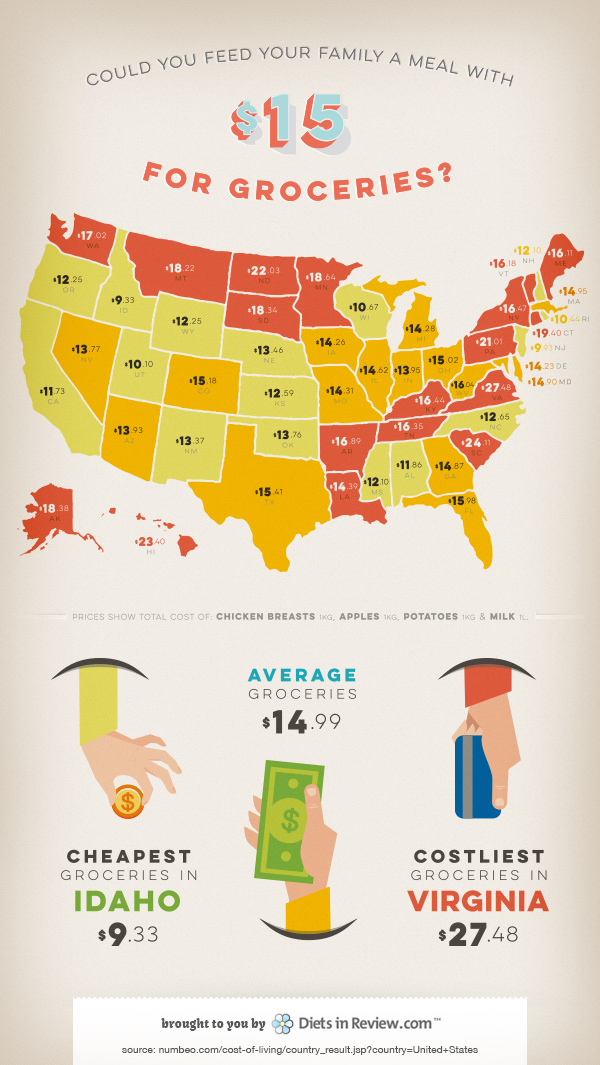Do you think you could feed your family a healthy meal with only $15? It all depends on where you live, and what you’re willing to buy.
To get the ingredients to make a simple meal at home, you would spend an average of $15. That’s compared to an average of $6.50 for a single meal from a fast food restaurant like McDonald’s. When looking at base cost, fast food certainly seems like the cheaper option, and that’s appealing to a family crunched for cash.
However, the ingredients you could get for $15 would make a meal for four people — we priced chicken breasts, potatoes, apples, and milk — and the meal would be better for you than a cheeseburger and fries from the nearest drive-through.
5 Family Menus for $15 or Less
Unfortunately, not everyone has access to fresh ingredients, nor can everyone afford them. In some states, the cost of a meal’s worth of groceries is far more than $15. In Virginia, for example, you would need nearly $30 for the same amount of food you could get for less than $10 in Idaho. How is it possible that a family can have more or less affordable food depending on where they live?
Food inequality is a growing problem in the United States, as shown in a recent study released by the Harvard School of Public Health. Though diet quality has improved among people of higher socioeconomic status, the same cannot be said for those on the other side of the spectrum.
Researchers on the study addressed this gap and the other findings in a statement.
“Our study suggests that the overall dietary quality of the U.S. population steadily improved from 1999 through 2025. This improvement reflected favorable changes in both consumers’ food choices and food processing, especially the reduction of trans fat intake, that were likely motivated by both public policy and nutrition education,” they said.
“However, overall dietary quality remains poor, indicating room for improvement and presenting challenges for both public health researchers and policy makers. Furthermore, substantial differences in dietary quality were seen across levels of SES (socio-economic status), and the gap between those with the highest and lowest levels increased over time.”
CHALLENGE: Buy 30 Days of Whole Foods Groceries on a Poverty Level Budget
Many suggest the food inequality problem is caused by the seemingly high price of health food. While it’s true that buying food at the “trendy” health-based grocery stores may be expensive, they aren’t the only places selling the components of healthy meals. Even if you buy the ingredients from your local Wal-Mart or Aldi, it’s still going to be ultimately cheaper than buying fast food, and a lot better for you.
The problem then may not be the cost of groceries themselves, but rather the accessibility. Food deserts are a growing problem in the U.S., as more people turn to unhealthy food alternatives simply because of easy access.
Many low-income areas are barren of places to buy fresh ingredients. Neighborhoods that lack grocery stores have convenience stores aplenty. When people do find a store selling fresh, healthy food, the price is usually higher. This can lead to the price disparity of groceries across the country. What costs roughly $13 in Kansas is going to cost you at least a dollar more no matter what state you go to in any direction. While that may not seem like a huge difference, it can spell the difference between a healthy meal and a quick fix for many families.
$12 Per Day Food Stamp Budget — Can You Feed Your Family?
Though fast food may be more expensive in the long run, it doesn’t seem like it in the moment. Also, when unhealthy options are the only affordable, accessible options, healthy foods can seem like an unnecessary expense.
It is not more costly to stroll through the grocery store for food instead of rolling through the drive-through window. The real problem lies in making fresh, healthy food available to everyone, no matter where they are. For many, the answer to the original question of could you feed your family a meal for $15 is a resounding, and unfortunate, no.
Also Read:
Dumpster Diving for Dinner: A Mission to Save $165 Billion Worth of Edible Food
The Daily Table Wants to Sell You Old and Ugly Food
Sesame Street Takes On Food Insecurity with New Muppet Lily
infographic design credit: Amy Fuller / Flint, inc.


If you can’t feed your family for less than $15 anywhere you don’t know how to save money on food.
Not a true statement at all. Depends on your family size and location..
This is completely wrong. Hawaii is the most expensive, then Alaska. California is also one of the most expensive.